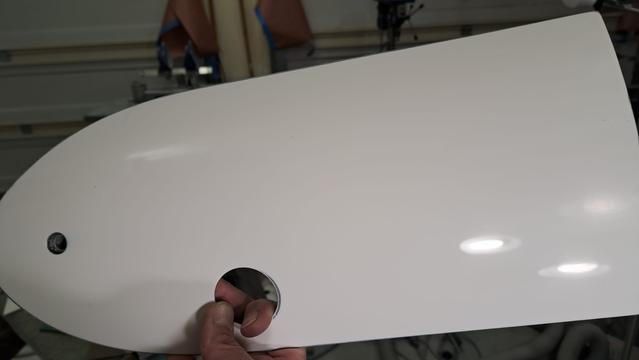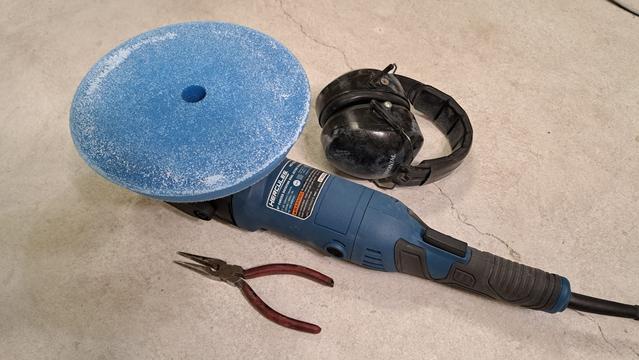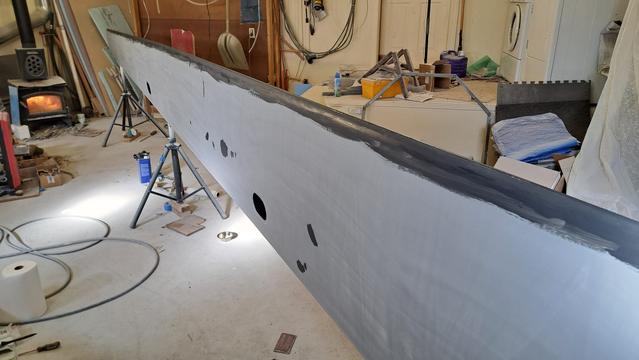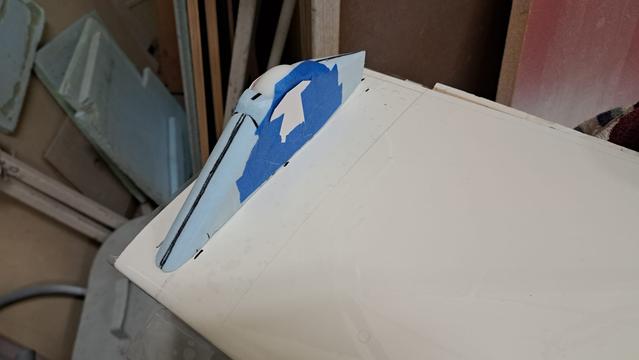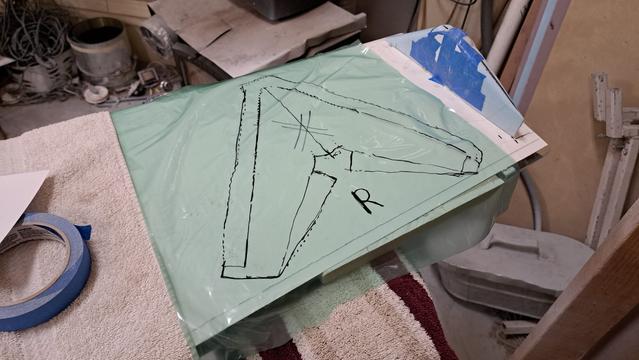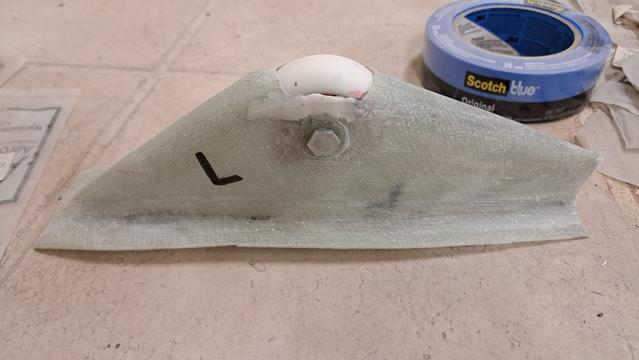Recent searches
Search options
#glider
Polishing the glider's paint - a brief experiment with an electric dual-action polisher on a test piece.
I used a coarse foam disk and cutting/buffing (not polishing) compound. The machine was at the lowest speed and light pressure was used for a minute or two.
This is a promising follow up to: https://universeodon.com/@KrajciTom/114197665061988882
The difference in surface prep was obvious. Where the paint had been sanded with 1200, the surface gained a gloss almost instantly. If the surface was sanded with 600, it remained hazy. Those sections only sanded with 400 were very hazy, even with more polishing time and a bit more pressure.
It looks like I'll hand sand to 1200, then use the electric polisher.
I just had an idea. If I build a bracket/clamp to hold the polisher upside down, I can hold small parts and better control the process.
#avgeek #aviation #ElectricAircraft #ExperimentalAviation #homebuilt
#Glider #DIY #Paint #Sand #Buff #Polish
#vinyl #schallplattensammlung #vinylcollection #vinylisation #vinylmontag #herrmontagvinyl
Holy Wing Flex Batman! Super Salto sailplane with a BS TJ-100 jet engine on performs at the Edwards Air Force Base Show. October 2022 It was quite a performance #aviationphotography #glider #gliding #sailplane #salto #planespotting #aviation #AvGeek #spotter #photography #aircraft #Nikon #Z9
The two fiberglass wingtip wheels have been sanded, cleaned with acetone, then covered (sloppy brush) with two thick coats of polyester primer.
They are now curing next to the garage wood stove.
Tomorrow morning they will be ready for sanding to prep them for final spray painting.
#avgeek #aviation #ElectricAircraft #ExperimentalAviation #homebuilt
#Glider #DIY #Wing #Fiberglass #Composite #Primer #Paint
Glider (early Mac game) being ported to the Apple II by @colin_mcmillen
#Apple #AppleII #Macintosh #glider #retrocomputing #vintagecomputing #retrogaming #games #macgames #AppleIIForever
New sprite is generated by C code that take a PNG in and dump relevant .s and .inc files. It is much more satisfying.
Am I going to try and make a #Glider clone? Maybe.
The wing now has two coats of dark gray primer along the leading edge to seal all the bubbles from the epoxy/microsphere filler. (Applied with a brush, not sprayed.)
Tomorrow I will start sanding it smooth. If there are enough unfilled bubbles, I'll mix another batch and use a Q-tip for spot repairs.
Now it's time for a shower.
#avgeek #aviation #ElectricAircraft #ExperimentalAviation #homebuilt
#Glider #DIY #Wing #Paint #Primer #Sand
Making a fiberglass wingtip wheel for the glider wing.
1st photo - making the mold/form out of foam, with a 60mm diameter inline skate wheel in place. Note that the underside of the wing is covered with clear tape to protect it from epoxy when I lay up 7 plies of glass.
2nd photo - making the fabric template. A single piece of glass fabric (weave 7725 because it drapes so well over various curves and corners) will make the final part, but there will be an overlap along the trailing edge. I draped a piece of plastic over the foam form after it was hot-glued to the wing and then traced out the pattern, with some reference marks such as a center line.
3rd - Demolding the cured part by squeezing it so that it flexes/distorts a bit...and the epoxy at the base easily shears off from the waxed clear tape. (No need for hammer and wedges.)
4th - rough sanded final part.
#avgeek #aviation #ElectricAircraft #ExperimentalAviation #homebuilt
#Glider #DIY #Wing #Fiberglass #Epoxy #Composite
The glider fuselage is on its side and I'm sanding one half of the fuselage in this orientation.
I'm sanding with a very flexible piece of foam rubber. My goal is to prep the surface for final painting. I'm using 220 grit today.
Tomorrow I'll flip the fuselage over to work the other side.
My final grit before painting will be 400.
#avgeek #aviation #ElectricAircraft #ExperimentalAviation #homebuilt
#Glider #DIY #Primer #Paint #Sanding
Time lapse video showing the approach of a back door cold front over the Sacramento mountains of southern New Mexico.
This is a classic example of convergence that glider pilots love. Two different temperature air masses are slowly colliding.
This cold front is not very deep, so it behaves like a blunt wedge/spatula as it pushes west. (The high altitude winds are blowing in the opposite direction.)
The canopy has been removed from the fuselage so that I can glue in round foam 'rod' that will serve as a seal when the canopy is closed onto the canopy rail.
Tomorrow I will flip the canopy end-for-end and finish gluing the rest of the foam.
Fitting the foam will be through trial and error. In some sections the foam will be too thick...I'll sand it down. In sections where the foam is not thick enough...I'll put a thick layer of tape on the canopy rail.
A good canopy seal helps reduce noise, cold air leaks at high altitude, and can even improve glide performance a tiny bit.
#avgeek #aviation #ElectricAircraft #ExperimentalAviation #homebuilt
#Glider #DIY
#Canopy #RTVsilicone #Adhesive
StratoSoar Glider Flies Itself from High Altitude - As the technology available to the average hacker and maker gets better and cheape... - https://hackaday.com/2024/09/23/stratosoar-glider-flies-itself-from-high-altitude/ #autonomousaircraft #high-altitude #dronehacks #glider
The wing water ballast tank push rods have been cut to length and appear to mechanically function as intended. (There is a cockpit control lever for each ballast tank drain valve.)
This evening, I will add water to the wing tanks for the first operational ground tests.
(This is a follow up to:
https://universeodon.com/@KrajciTom/112878920935247492 )
#avgeek #aviation #ElectricAircraft #ExperimentalAviation #homebuilt
#Glider
Making an Aluminium Foil Glider to Prototype Hydroforming - Hydroforming is a very effective way to turn a ductile metal like aluminium or sta... - https://hackaday.com/2024/07/30/making-an-aluminum-foil-glider-to-prototype-hydroforming/ #hydroforming #dronehacks #glider
When I was a kid, these kinds of swings were everywhere in the Maritimes. I knew them as boat swings. What do you call them? https://internatshop.top/ProductDetail.aspx?iid=368491323&pr=71.88 #BoatSwing #Swings #swing #glider
#SkyingHour Q2 hat's the best thing you've seen in the sky (or air or space) this week?
This week I saw a lot of #gliders over #Oxfordshire during a #gliding competition.
Could the 'flying piano' help transform air cargo?
https://www.bbc.com/news/articles/c0kk4lxe702o #airtransport #cargo Aerolane #glider
For this #ScreenshotSaturday, here's a work-in-progress player sprite for the Taiyaki Fabulous Museum of Fish (#TaiFab), which I am developing in #GBStudio. I'm making progress on #GameDev slowly but surely.
This second video shows the full span flaperon being raised and lowered on one wing.
The flaperon serves two purposes:
- Aileron. Control of bank angle/roll axis rotation when one wing's aileron goes up, the other wing's aileron goes down.
- Flap. Both wings raise or lower the flaps to alter the camber of the airfoil. For low speed flight the camber is increased (flaps down). High speed flight requires decreased camber (flaps up, and even flaps 'negative' so that the flaps go way up).
(Inside the fuselage there is a mechanical mixer that combines the action of the control stick (side to side for aileron input), and the flap lever.)
#ExperimentalAviation
#Homebuilt
#GeneralAviation
#Glider
#avGeek
#Aviation



